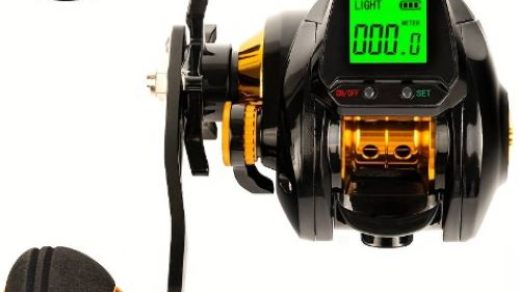When it come to baitcasting reels, one of the pivotal decisions anglers face is selecting the most suitable gear ratio. The gear ratio, often regarded as the heart of a baitcaster, determines the speed and power of the reel’s retrieve. Understanding the nuances of gear ratios can significantly enhance one’s angling experience, leading to more successful outings on the water.
In the realm of baitcasters, gear ratios are expressed as a numerical ratio, indicating the number of revolutions the spool makes with each turn of the handle. For instance, a gear ratio of 6.4:1 means the spool rotates 6.4 times for every full turn of the handle. These ratios vary across a spectrum, ranging from high-speed retrieves to slower, torque-focused options.
The quest for the ideal gear ratio is a nuanced endeavor, heavily influenced by an array of factors such as lure presentation, fishing technique, and the species being targeted. Anglers often find themselves at a crossroads, weighing the merits of high-speed retrieves against the power and control afforded by slower gear ratios.
Stay tuned as we unravel the complexities of gear ratios in baitcaster reels, providing insights to help anglers make informed decisions and maximize their effectiveness on the water.
Analyzing High-Speed Gear Ratios:
In the realm of baitcaster reels, high-speed gear ratios, typically ranging from 7.0:1 and above, are favored for their rapid line retrieval capabilities. Anglers employing techniques such as flipping, pitching, and burning spinnerbaits often gravitate towards these gear ratios to capitalize on quick lure presentations and cover extensive water in a short amount of time.
The primary allure of high-speed gear ratios lies in their ability to facilitate rapid lure retrieval, making them ideal for applications where speed is paramount. When fishing in situations that demand quick lure movements or covering vast expanses of water, such as when targeting actively feeding bass or swiftly moving schools of fish, a high-speed gear ratio can be a game-changer.
Moreover, high-speed gear ratios excel in scenarios where anglers need to swiftly reel in slack line to maintain constant contact with their bait or quickly pull fish out of heavy cover. This is particularly advantageous when fishing in dense vegetation or around submerged structure, where swift, forceful retrieves are necessary to prevent snagging and promptly extract fish from cover.
Additionally, high-speed gear ratios offer anglers the versatility to employ a wide range of fishing techniques effectively. From burning lipless crankbaits across expansive flats to executing rapid-fire casts with topwater lures along shoreline cover, the agility afforded by high-speed gear ratios empowers anglers to adapt to changing conditions and capitalize on fleeting opportunities.
However, it’s essential for anglers to exercise caution when utilizing high-speed gear ratios, as they can sometimes compromise torque and power, particularly when battling larger, hard-fighting fish. In situations where finesse and precision are paramount, such as when fishing finesse techniques or battling stubborn trophy-sized fish, anglers may find themselves at a disadvantage with high-speed gear ratios.
Exploring Moderate-Speed Gear Ratios:
In the realm of baitcaster reels, moderate-speed gear ratios, typically ranging from 6.0:1 to 7.0:1, occupy a versatile middle ground, offering a balanced blend of speed and power. Anglers who prefer a more versatile approach to their fishing endeavors often find themselves drawn to these gear ratios, appreciating their adaptability across a wide range of fishing techniques and scenarios.
A moderate-speed gear ratio strikes a harmonious balance between the rapid retrieve of high-speed gear ratios and the enhanced torque and power of slower gear ratios. This balance makes them well-suited for a diverse array of fishing applications, allowing anglers to effectively fish a broad spectrum of lures and techniques with confidence.
One of the primary advantages of moderate-speed gear ratios is their versatility across various fishing techniques. Whether it’s working jigs and worms along the bottom, cranking medium-depth diving crankbaits, or even throwing swimbaits and jerkbaits, moderate-speed gear ratios provide anglers with the flexibility to adapt to different presentations and conditions.
Moreover, moderate-speed gear ratios excel in scenarios where a balance of speed and power is required. When targeting species like bass, walleye, or pike in a variety of environments, from open water to heavy cover, a moderate-speed gear ratio offers the agility to make precise presentations while still providing the muscle to handle hard-fighting fish and navigate challenging terrain.
Another notable advantage of moderate-speed gear ratios is their efficiency in conserving angler energy over prolonged fishing sessions. While not as demanding on the wrists and forearms as high-speed gear ratios, moderate-speed reels still offer a respectable rate of retrieve, allowing anglers to cover water efficiently without sacrificing comfort or stamina.
To illustrate the versatility of moderate-speed gear ratios, consider the following table showcasing some common fishing techniques and their compatibility with this gear ratio:
| Fishing Technique | Compatibility with Moderate-Speed Gear Ratios |
| Jigging/Worming | Excellent |
| Medium-Diving Crankbaits | Very Good |
| Topwater Presentations | Good |
| Spinnerbaits/Chatterbaits | Good |
| Pitching/Flipping | Very Good |
Embracing Low-Speed Gear Ratios:
In the world of baitcaster reels, low-speed gear ratios, typically ranging from 5.0:1 and below, embody a paradigm of power and control. Anglers who prioritize torque over speed often find themselves drawn to these gear ratios, appreciating their ability to exert maximum force and finesse when battling large, hard-fighting fish or navigating dense cover.
Low-speed gear ratios excel in scenarios where slow, methodical presentations are key to enticing strikes or where brute force is required to haul fish out of heavy cover. Techniques such as deep cranking, dragging heavy jigs or swimbaits along the bottom, and slow-rolling spinnerbaits are ideally suited to the deliberate pace afforded by low-speed gear ratios.
One of the primary advantages of low-speed gear ratios is their ability to generate substantial torque, making them indispensable tools for tackling big fish in challenging environments. Whether it’s muscling trophy-sized bass out of thick vegetation or wrestling monster pike from submerged timber, anglers can rely on the raw power of low-speed gear ratios to get the job done.
Moreover, low-speed gear ratios offer anglers enhanced control over their presentations, allowing for precise lure placement and subtle adjustments in retrieve speed. When finesse and subtlety are paramount, such as when fishing in clear water or targeting highly pressured fish, the slower pace afforded by low-speed gear ratios can make all the difference in enticing hesitant strikes.
Another notable advantage of low-speed gear ratios is their efficiency in conserving bait and maximizing time spent in the strike zone. By allowing lures to maintain contact with the bottom for extended periods or keeping them within the strike zone of suspended fish, low-speed gear ratios increase the likelihood of triggering a reaction strike and maximizing angler success.
To illustrate the effectiveness of low-speed gear ratios across different fishing scenarios, consider the following table showcasing some common techniques and their compatibility with this gear ratio:
| Fishing Technique | Compatibility with Low-Speed Gear Ratios |
| Deep Cranking | Excellent |
| Bottom Jigging/Swimming | Excellent |
| Slow-Rolling Spinnerbaits | Very Good |
| Pitching/Flipping | Very Good |
| Carolina Rigging | Good |
Strategies for Choosing the Right Gear Ratio:
Selecting the optimal gear ratio for a baitcaster reel involves a thoughtful consideration of various factors, including fishing technique, lure presentation, and the species being targeted. To assist anglers in making informed decisions, several strategies can be employed to match gear ratios with specific fishing scenarios and preferences.
- Assess Fishing Technique: Different fishing techniques require varying levels of speed, power, and precision. Anglers should evaluate their preferred techniques and consider how different gear ratios align with those approaches. For instance, anglers who primarily fish topwater lures may benefit from high-speed gear ratios for quickly covering water and keeping lures in motion, while those who specialize in bottom presentations might lean towards low-speed gear ratios for precise lure control and extended time in the strike zone.
- Consider Lure Compatibility: The type and weight of lures being used play a crucial role in determining the ideal gear ratio. Lighter lures typically benefit from higher-speed gear ratios, as they require less effort to retrieve and can be worked more efficiently with faster retrieves. Conversely, heavier lures, such as deep-diving crankbaits or heavy jigs, may necessitate the torque and power provided by lower-speed gear ratios to maintain control and prevent fatigue during extended retrieves.
- Evaluate Target Species and Environment: Understanding the behavior and habitat preferences of the target species is essential in selecting the appropriate gear ratio. For example, when targeting bass in shallow cover or fast-moving current, a higher-speed gear ratio may be advantageous for quickly covering water and capitalizing on active feeding periods. Conversely, when pursuing bottom-dwelling species like catfish or walleye in deeper waters, a lower-speed gear ratio may offer the control and precision needed for precise presentations and efficient bait management.
- Balance Speed and Power: Ultimately, anglers must strike a balance between speed and power that aligns with their fishing style and preferences. While high-speed gear ratios excel in certain scenarios, they may lack the torque needed to handle larger fish or heavy cover effectively. Conversely, low-speed gear ratios offer unmatched power and control but may sacrifice speed and versatility in certain fishing situations. Moderate-speed gear ratios provide a versatile middle ground, offering a balanced blend of speed, power, and efficiency across a wide range of fishing techniques and environments.
By employing these strategies and carefully evaluating their fishing needs and preferences, anglers can confidently select the optimal gear ratio for their baitcaster reels, maximizing their effectiveness on the water and enhancing their angling success.
Strategies for Choosing the Right Gear Ratio
| Strategy | Description |
| Assess Fishing Technique | Evaluate preferred fishing techniques and match gear ratios accordingly. |
| Consider Lure Compatibility | Determine how gear ratios align with the weight and type of lures being used. |
| Evaluate Target Species and Environment | Consider the behavior and habitat preferences of the target species and fishing environment. |
| Balance Speed and Power | Strike a balance between speed and power that aligns with fishing style and preferences. |
Conclusion: Deciphering the Gear Ratio Puzzle
In the dynamic world of baitcaster reels, the gear ratio stands as a critical determinant of an angler’s success on the water. Throughout this exploration, we’ve traversed the spectrum of gear ratios, from the lightning-fast retrieves of high-speed ratios to the formidable torque of low-speed counterparts. Each gear ratio offers its own unique blend of speed, power, and control, catering to a diverse array of fishing techniques, environments, and preferences.
As anglers, our pursuit of the perfect gear ratio is not merely an exercise in technicality but a quest for mastery over the intricacies of our craft. It’s a journey marked by experimentation, adaptation, and a deepening understanding of the symbiotic relationship between angler and reel.
In the tapestry of fishing, gear ratios serve as threads that weave together the fabric of our experiences, shaping the cadence of our retrieves, the precision of our presentations, and the thrill of our hooksets. Whether racing across open water in pursuit of elusive predators or methodically probing the depths for hidden treasures, our choice of gear ratio becomes an extension of our angling ethos—a reflection of our individual style, strategy, and spirit.
So, as you embark on your next angling adventure, armed with the knowledge gleaned from this exploration, may you navigate the waters with confidence, equipped with the perfect gear ratio to unlock the mysteries that lie beneath the surface. And remember, in the ever-evolving saga of fishing, the gear ratio is not just a number—it’s a key to unlocking the wonders of the aquatic realm, one revolution at a time.




